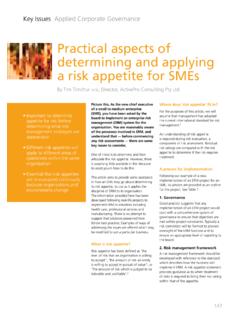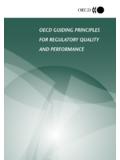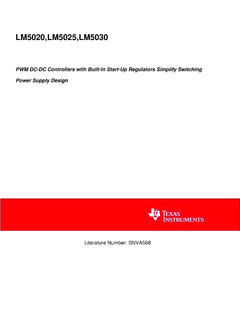Transcription of Beyond Explainability: A Practical Guide to …
1 Beyond Explainability: A Practical Guide to Managing Risk in Machine Learning Models Andrew Burt Stuart Shirrell Chief Privacy Officer and Legal Engineer, Legal Engineer, Immuta Immuta Brenda Leong Xiangnong (George) Wang Senior Counsel and Director of 2018 Immuta Scholar;. Strategy, Future of Privacy Forum Candidate, Yale Law School How can we govern a technology its creators can't fully explain? This is the fundamental question raised by the increasing use of machine learning (ML) a question that is quickly becoming one of the biggest challenges for data-driven organizations, data scientists, and legal personnel around the This challenge arises in various forms, and has been described in various ways by practitioners and academics alike, but all relate to the basic ability to assert a causal connection between inputs to models and how that input data impacts model output. According to Bain & Company, investments in automation in the US alone will approach $8 trillion in the com- ing years, many premised on recent advances in But these advances have far outpaced the legal and ethical frameworks for managing this technology.
2 There is simply no commonly agreed upon framework for governing the risks legal, reputational, ethical, and more associated with ML. This short white paper aims to provide a template for effectively managing this risk in practice, with the goal of providing lawyers, compliance personnel, data scientists, and engineers a framework to safely cre- ate, deploy, and maintain ML, and to enable effective communication between these distinct organizational perspectives. The ultimate aim of this paper is to enable data science and compliance teams to create better, more accurate, and more compliant ML Does It Matter How Black the Black Box Model Is? Many of the most powerful ML models are commonly referred to as black boxes, due to the inherent difficul- ty in interpreting how or why the models arrive at particular results. This trait is varyingly addressed as unin- terpretability, unexplainability, or opacity in the legal and technical literature on ML.
3 But a model's perceived opacity is often the result of a human decision: the choice of which type of ML model to apply. Predictive accuracy and explainability are frequently subject to a trade-off; higher levels of accuracy may be achieved, but at the cost of decreased levels of While limitations on literal explainability are a central, fundamental challenge in governing ML, we recommend that data scientists and lawyers document this trade off from the start, due to the fact that there are various ways to balance accuracy against explainability. Data scientists might seek to break down the decision they're predicting using ensemble methods, for example, utilizing multiple models to maximize accuracy where nec- essary while maximizing explainability in other areas. Any decrease in explainability should always be the result of a conscious decision, rather than the result of a reflexive desire to maximize accuracy. All such decisions, including the design, theory, and logic underlying the models, should be documented as Similarly, we recommend all lines of defense take into account the materiality of the model deployment.
4 Broadly speaking, the concept of materiality arises from evaluating the significance or personal impact of the model on the organization, its end users, individuals, and third parties. In practice, for example, a model making movie recommendations will have lower impact and therefore should allow a higher tolerance for unknown risks than a model used in a medical environment, the results of which could have a direct impact on patient health. Beyond Explainability Page 2. Key Objectives & The Three Lines of Defense Projects that involve ML will be on the strongest footing with clear objectives from the start. To that end, all ML projects should begin with clearly documented initial objectives and underlying assumptions. These objectives should also include major desired and undesired outcomes and should be circulated amongst all key stakeholders. Data scientists, for example, might be best positioned to describe key desired outcomes, while legal personnel might describe specific undesired outcomes that could give rise to legal liability.
5 Such outcomes, including clear boundaries for appropriate use cases, should be made obvious from the outset of any ML project. Additionally, expected consumers of the model from individuals to systems that employ its recommendations should be clearly specified as Once the overall objectives are clear, the three lines of defense should be clearly set forth. Lines of de- fense inspired by model risk management frameworks like the Federal Reserve Board's Supervision and Regulation Letter 11-7 refer to roles and responsibilities of data scientists and others involved in the process of creating, deploying, and auditing ML. SR 11-7, for example, stresses the importance of effective challenge . throughout the model lifecycle by multiple parties as a crucial step that must be distinct from model develop- ment The ultimate goal of these measures is to develop processes that direct multiple tiers of person- nel to assess models and ensure their safety and security over time.
6 Broadly speaking, the first line is focused on the development and testing of models, the second line on model validation and legal and data review, and the third line on periodic auditing over time. Lines of defense should be composed of the following five roles: Data Owners: Responsible for the data used by the models, often referred to as database administra- tors, data engineers, or data stewards.. Data Scientists: Create and maintain models. Domain Experts: Possess subject matter expertise about the problem the model is being used to solve, also known as business owners.. Validators: Review and approve the work created by both data owners and data scientists, with a focus on technical accuracy. Oftentimes, validators are data scientists who are not associated with the specific model or project at hand. Governance Personnel: Review and approve the work created by both data owners and data scientists, with a focus on legal risk.
7 Some organizations rely on model governance committees which represent a range of stakeholders impact- ed by the deployment of a particular model to ensure members of each above group performs their respon- sibilities, and that appropriate lines of defense are put in place before any model is While helpful, such review boards may also stand in the way of efficient and scalable production. As a result, executive-led model review boards should shift their focus to developing and implementing processes surrounding the roles and responsibilities of each above group. These boards should formulate and review such processes before they are carried out and in periodic post-hoc audits, rather than individually reviewing each model before deployment. We make further recommendations below as to how to develop these three lines of defense. Critically, these recommendations should be implemented in varying degrees, consistent with the overall risk associated with each model.
8 Every model has unforeseen risks, but some deployments are more likely to demonstrate bias and result in adverse consequences than others. As a result, we recommend that the depth, intensity, and Beyond Explainability Page 3. frequency of review factor in characteristics including: the model's intended use and any restrictions on use (such as consumer opt out requirements), the model's potential impact on individual rights, the maturity of the model, the quality of the training data, the level of explainability, and the predicted quality of testing and Implementing the Three Lines of Defense A select group of data owners and data scientists comprise the first line of defense, documenting objectives and assumptions behind a particular ML project. Another group of data scientists, designated as validators, serves as the second line, along with legal personnel, who together review data quality assessments of the data used by the model, model documentation, key assumptions, and methodologies.
9 It's critical that data scientists in the second line also serve in the first line in other projects, in order to ensure that expertise is sufficiently distributed. A third line of defense includes periodic reviews of the underlying assumptions behind the model, including the recommendations below. We recommend third line reviews no less-frequently than every six months. These reviews, however, should be tailored to the specific risks of the ML in deployment, and to the specific compliance burden as Focusing on the Input Data Once proper roles and processes have been put in place, there is no more important aspect to risk manage- ment than understanding the data being used by the model, both during training and deployment. In practice, maintaining this data infrastructure the pipeline from the data to the model is one of the most critical, and also the most overlooked, aspects of governing Broadly speaking, effective risk management of the un- derlying data should build upon the following recommendations: Document Model Requirements: All models have requirements from freshness of data, to specific features required, to intended uses, and more which can impact model performance, all of which need to be documented This enables validators to properly review each project and ensure that mod- els can be maintained over time and across personnel.
10 Similarly, data dependencies will inevitably exist in surrounding systems that feed data into the model; where these dependencies exist, they should be documented and monitored. Additionally, documentation should include discussion of where personally identifiable information is included and why, how that data has been protected (through encryption, hash- ing, or otherwise), along with the traceability of that data. Assess Data Quality: Understanding the quality of data fed into a model is a key component of model risk, and should include an analysis of: completeness, accuracy, consistency, timeliness, duplication, validi- ty, availability, and provenance. Many risk management frameworks rely on the so-called traffic light sys- tem for this type of assessment, which utilizes red, amber, and green colors to create a visual dashboard to represent such assessments. Beyond Explainability Page 4. Encapsulate the Model: Separating the model from the underlying infrastructure allows for vigorous testing of the model itself and the surrounding processes.










